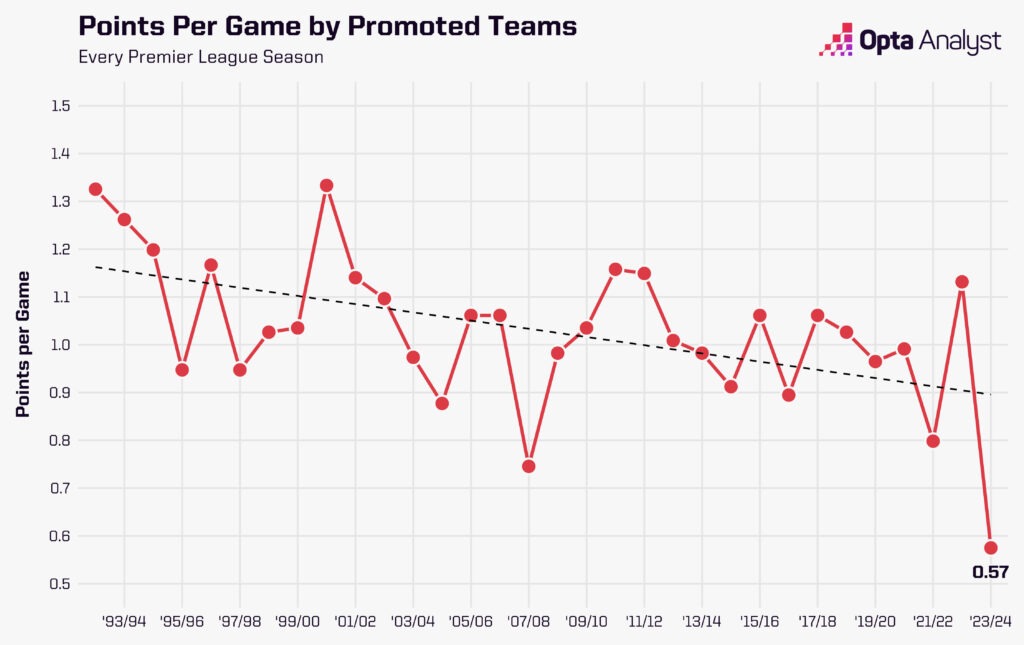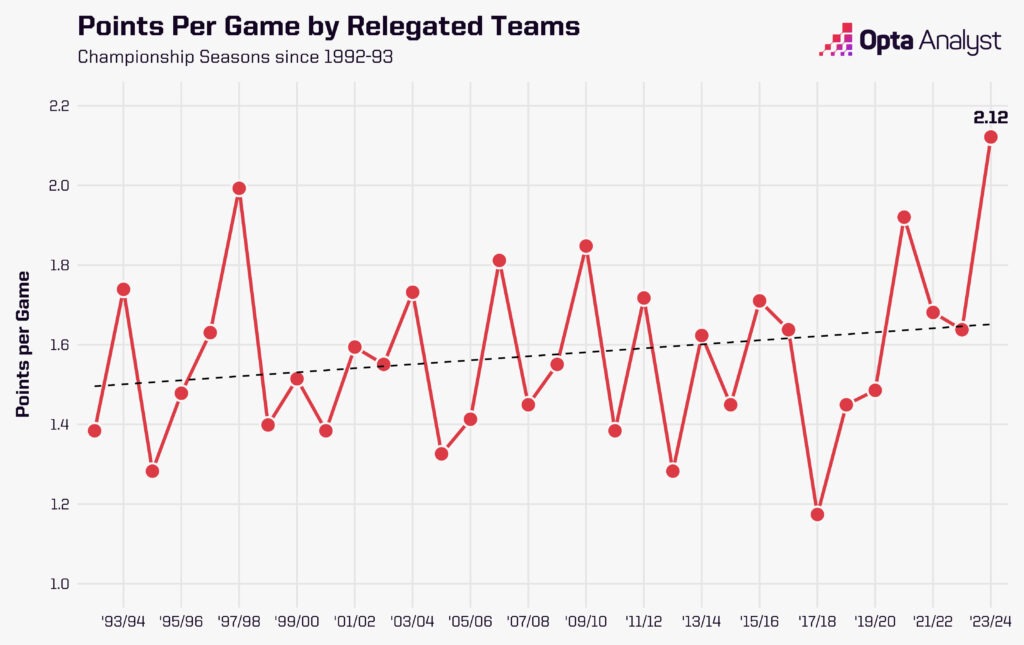The gap between the best and the worst teams in the Premier League is bigger than ever before. We examine why, and wonder where the top flight of English football is headed.
Last weekend, the Premier League’s top five all won. Four of them were making it three wins in a row. Two of them haven’t lost this year.
At the other end of the table, the bottom five all lost. Two of them haven’t won in at least nine games. The bottom six have just four wins between them in their last 42 games combined (each team’s last seven games).
The top teams are getting better, and while the bottom teams aren’t necessarily getting worse, it is harder than ever before to keep up. We therefore have a Premier League table more stretched out than ever before.
We might be seeing the closest title race in a decade, but there are knock-on effects of three teams dominating so much.
This season isn’t quite seeing the highest collective points total for the top three at this stage of a Premier League campaign (186 points – five short of 2018-19’s record of 191) but it’s fair to say we’ve never seen such widespread quality at the top of the table. Manchester City, Liverpool and Arsenal are all more than good enough to win the title. Each of them probably would do in most other Premier League seasons.
They are harder to beat than ever before, and given their recent form, it’s difficult to see where any of them will slip up – other than when they have to play each other. The result of them playing so well and pushing each other to these heights is that upsets are becoming rarer.
Aston Villa and Tottenham aren’t quite so immune to slipping up, but they are certainly playing their part in the overall quality at the top of the Premier League being so high this season.
Meanwhile, the teams at the other end of the table have never felt so far away. The three promoted sides have been favourites for the drop all season, and although Luton are making a decent go of life back in the top flight, they have lost four in a row and are winless in five following a mini mid-season resurgence around the turn of the year.
The combined record of Luton, Burnley and Sheffield United reads: played 80, won 11, drawn 13, lost 56. They have conceded a total of 186 goals – mainly thanks to Sheffield United’s potentially record-breaking defence – and have a combined goal difference of -102. Despite playing more than two seasons’ worth of games, they only have 46 points between them.
The gap between first and last isn’t quite as big this season (50 points) as it has been after 27 rounds of fixtures in some other Premier League campaigns, for example when one team has run away with it at the top or a particularly bad team has been cut adrift at the bottom.
But looking at the gap between fourth – which has for years been the final Champions League place and is therefore a decent indicator of a cut-off in terms of wealth – and 18th, the final relegation spot, is telling. The 35-point gap between fourth and 18th right now is the largest it has ever been at this stage in a 20-team Premier League season.
That gap has only twice before been as high as 30 points (2013-14 and 2016-17) and never higher than 31. In 15 of the 29 Premier League seasons in which 20 teams have competed, the gap has been 25 points or fewer.
The top four has never been as out of reach as it is now for promoted clubs.
Financial disparity as you go down the league is presumably the explanation for this chasm. Champions League prize money is greater than ever before, and while the Premier League’s Profit and Sustainability rules are surely a good thing in that they should help protect teams from spending beyond their means and running into financial difficulties, they do mean that it is quite literally impossible for anyone to spend their way into the elite. It’s likely to take the now-mind-blowingly-rich Newcastle far longer, for example, to break the glass ceiling that stops them from winning the Premier League than it did, say, Manchester City.
Another contributing factor has been the rejig of the rules this season to clamp down on time-wasting, which have inadvertently given bigger teams more of an advantage.
Matches are longer than ever before, with games lasting more than 100 minutes (101:39) on average for the first time. It’s no coincidence that this season has brought the latest Premier League goal on record (since 2006-07, when exact goal times became available), the third-latest, the fourth-latest, the sixth-latest, the eighth-latest, and the 10th-latest. Tottenham’s comeback win over Sheffield United in September, meanwhile, broke the record for the latest a team has trailed in a game (97:33) that they have then gone on to win.
Longer games and the increase to allow five substitutes favour the biggest teams with the deepest squads and the managers who can therefore call on more high-quality players late on in games. Bigger teams have longer to grind stubborn opponents down and they are succeeding. With 11 games of the season remaining, Liverpool are only two goal involvements off equaling the record in a Premier League season for goals and assists by substitutes, with 22 (two behind City’s 24 in 2011-12). Liverpool have scored more goals in second-half injury time in Premier League games this season (eight) than any other team, closely followed by Arsenal (seven). The best teams are, unsurprisingly, performing best late on in games.
Meanwhile, the tactics that lesser teams might use to see out a result are seen as part of the problem that these new directives have been brought in to fix. Time-wasting is something that frustrates people no end, but it’s questionable that the current rule changes are the way to deal with the issue.
Now, Manchester City can essentially waste time legally by passing the ball around ad infinitum because they have the resources and players to play that way. Luton and Sheffield United, meanwhile, aren’t as good at keeping hold of the ball, and they are punished for not getting the ball back into play as quickly as possible with more game time for their tired players to endure. The result is an increase in the imbalance between the best and the worst teams.
The three promoted teams are faring worse than in any other Premier League season, earning just 0.57 points per game. Promoted teams normally average more than one point per game, and have never previously won fewer than 0.7 per game.

Meanwhile, in the second tier, the three relegated sides – Leeds, Leicester and Southampton – are picking up more points than in any previous season. They are averaging 2.12 points per game – the most relegated sides have ever managed, with their 227 points so far this season already one more than in the whole of 2022-23. Ipswich are making a battle of it at the top of Championship, but generally, teams are finding it harder than ever to compete with those that drop down from the top flight.

So, what does this mean for the Premier League?
The top flight’s elite and the entire league itself are more of a closed shop than ever before. The gap between the best and the rest is bigger, and the step up from the Championship is increasingly hard to bridge.
Of course, Luton are still in touching distance of Nottingham Forest in 17th-place and safety, and they may well go on to survive. But while Rob Edwards might have them closer to the Champions League than they have ever been, the gap is widening and it’s getting harder for promoted teams to establish themselves in the top flight.
We’ve got the best title race in a decade, but for teams at the other end of the league, joining the elite is more of a pipe dream than ever before.
Enjoy this? Subscribe to our football newsletter to receive exclusive weekly content. You should also follow our social accounts over on X, Instagram, TikTok and Facebook.
